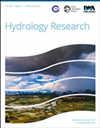加拿大魁北克Chaudière河动态破裂过程的全面实地调查
IF 2.4
4区 环境科学与生态学
Q2 Environmental Science
引用次数: 1
摘要
加拿大魁北克省的Chaudière河因其频繁的冰塞洪水事件而闻名。作为更大流域研究计划的一部分,在2018-2019年和2019-2020年冬季开展了广泛的实地活动,以量化Chaudière河沿岸断裂过程的时空特征。结果表明,中肖迪埃地区已形成隆冬期冰塞,并一直持续到春季解体。春季决裂在上肖迪埃河开始,然后几乎同时在中肖迪埃和下肖迪埃河段开始。由于坡度要温和得多,中肖迪埃河的决裂通常比河流的其他河段持续时间更长,而冬季中期冰塞的发生被认为会推迟清冰。已经确定了融化累积程度的逐河段特征和破裂开始时的排放阈值。在野外活动中,记录了51个冰塞,以及它们的位置、长度、形成日期和引发冰塞形成的形态特征。本研究中确定的破冰模式、结冰的水文气象阈值和冰塞地点可以作为实施预警系统的基础。本文章由计算机程序翻译,如有差异,请以英文原文为准。
A comprehensive field investigation of the dynamic break-up processes on the Chaudière River, Quebec, Canada
The Chaudière River in Quebec, Canada, is well known for its frequent ice jam flooding events. As part of a larger watershed research program, an extensive field campaign has been carried out during the 2018–2019 and 2019–2020 winter seasons to quantify the spatiotemporal characteristics of the break-up processes along the Chaudière River. The results showed that mid-winter ice jams have formed in the Intermediate Chaudière and persisted until spring break-up. Spring break-ups were initiated in the Upper Chaudière, and then, almost simultaneously, in the Intermediate and Lower Chaudière reaches. The break-up in the Intermediate Chaudière usually lasts longer than the rest of the river since the slope is much milder, and the occurrence of mid-winter ice jams has been seen to delay the ice clearing. A reach-by-reach characterization of the cumulative degree day of thawing and discharge thresholds for the onset of break-up has been identified. During the field campaign, 51 ice jams were documented together with their location, length, date of formation, and the morphological feature triggering jam formation. Break-up patterns, hydrometeorological thresholds of ice mobilization, and ice jam sites identified in this study can serve as a basis for the implementation of an early warning system.
求助全文
通过发布文献求助,成功后即可免费获取论文全文。
去求助
来源期刊

Hydrology Research
Environmental Science-Water Science and Technology
CiteScore
5.30
自引率
7.40%
发文量
70
审稿时长
17 weeks
期刊介绍:
Hydrology Research provides international coverage on all aspects of hydrology in its widest sense, and welcomes the submission of papers from across the subject. While emphasis is placed on studies of the hydrological cycle, the Journal also covers the physics and chemistry of water. Hydrology Research is intended to be a link between basic hydrological research and the practical application of scientific results within the broad field of water management.
 求助内容:
求助内容: 应助结果提醒方式:
应助结果提醒方式:


